By Jeffrey A. Rendall; Photos of Pinehurst No. 2 by Kevin Gaydosh
PINEHURST, NC – “We were quite the reluctant warriors, so to speak in this thing,” said Bill Coore, remembering his and partner Ben Crenshaw’s initial reaction to the notion of restoring the vaunted Pinehurst No. 2 course.
Their reluctance stemmed from the belief that such a timeless classic should only be altered with tremendous consideration and respect – and even then, you’re taking a big risk in the endeavor.
But it also would seem that Coore & Crenshaw would be just the right men to provide all of those things, as their work over the past twenty-five (plus) years has proven just that. If there’s a project where you’d like traditional architecture – even in a modern setting – then Bill and Ben should be high on your list.
The firm’s website explains their philosophy: “Admiration and respect for the classic golf courses of the ‘Golden Age of Architecture’ inspired Ben Crenshaw and Bill Coore to establish the firm of Coore and Crenshaw Inc. in 1986. Theirs is an architectural firm based upon the shared philosophy that traditional, strategic golf is the most rewarding, and the creation of courses that present this concept with the greatest artistry is the ultimate goal.
“They have blended their personal experience and admiration for the classical courses of Ross, Mackenzie, Macdonald, Maxwell, and Tillinghast to create a style uniquely their own.”
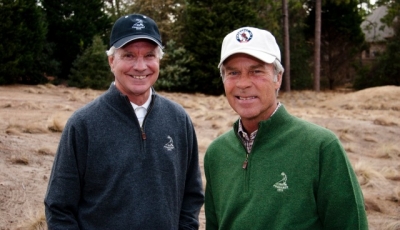 |
| Bill Coore and Ben Crenshaw at Pinehurst. |
That’s an understatement. We caught up with Bill Coore recently, and he was kind enough to share the A-Z story of Pinehurst #2’s restoration:
GolfTheUnitedStates.com: Even for such a massive undertaking as the restoration of Pinehurst #2, there had to be a starting point. How did you hear about the project?
Bill Coore: They (Don Padgett, the president of Pinehurst) called us and just said, “Ben, Bill, we’re giving some serious consideration to trying to restore #2 course and we’d just like to have a conversation with you to see if this is something you might be interested in -- and whether or not we even undertake the project at all.”
And so, Ben and I went there. Don, and certainly he was representing – Bob Dedman the owner was not there the first time we went, but was there shortly after. But Don Padgett said, for a number of years now we’ve been hearing that #2 has lost some of its character. That people who’ve played here, the older folks who played it – not that there are too many of them left from the 50’s – but the 50’s and 60’s, and even going back to our archives, we just realized that the course seemed to have more of a sense of individual character and personality than it does now.
We’ve been hearing this consistently for a number of years, and we’re just contemplating… do we try to restore some of that individual character to it?
So that’s how the conversation began. A couple of our immediate questions were… okay, anytime you talk about restoring a golf course, especially one with this much history, and one that’s so highly revered, the question immediately comes to the front: restore it to what?
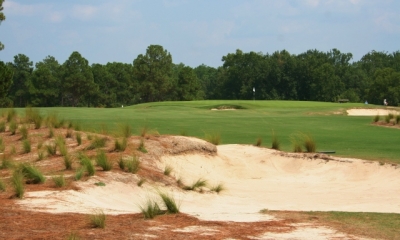 |
| The Sandhills look is restored to Pinehurst No. 2. Here, on the par four 3rd hole. |
The course has changed a lot, certainly over the last 40 years. It’d changed dramatically from one really quite natural looking that looked like it lay very gently on that sandhills land with the native landscape as the roughs.
Over the course of time, there was much more maintained turf grass. It’d basically become a parkland-type golf course.
It certainly still had those dramatically crowned greens that had become the signature of #2, but the rest of the course… it’d changed dramatically, and probably not in a positive fashion.
Although, as it was occurring, I’m sure the people who were making the decisions felt like it was positive to go where it looked more highly maintained. It just looked particularly like that period in golf from 1970 through the 90’s – we went through that era of maintenance.
And extreme maintenance becoming perceived as so integral to the quality of golf courses.
Pinehurst followed that trend for various reasons. Then there were these discussions that began internally with Pinehurst – that this is not what brought attention to it, in the beginning… this is not what Mr. Ross did when he completely reworked the course in 1935, when he grassed the greens and made sure they had irrigation in the fairways where they could grass fairways.
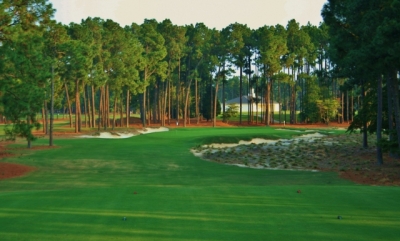 |
| Evening shadows on the par three 17th hole. |
What was there, up until a couple years ago was dramatically different from the golf course that basically had established Pinehurst #2’s reputation. And so internally they said ‘I think we need to seriously consider this.’ This was not Ben and me going to them, saying, ‘Gee, you ought to change this. You ought to fix this.’ We were quite the reluctant warriors, so to speak in this thing.
GolfTheUnitedStates.com: Sounds like it. Once the idea was hatched, how did you go about it?
Bill Coore: They said, would you do some study and see what you think? Come to us with an opinion and… I remember talking to Don Padgett and saying, Don, you’re talking to us about restoring a golf course, and restore it to what? He looked at me, and says, “Bill, that’s up to you and Ben. You tell us what it needs to be restored to.”
We began the research in the Tufts archives there, studying old photographs and information that they have so wonderfully preserved there. When you do that, it doesn’t take too long to come to the conclusion that probably the most interesting golf course that was ever at #2 was the one that existed from 1935 to really about the mid 60’s, I guess.
That truly was the golf course that established its reputation. And we were so fortunate that they had some nice photographs at the Tufts archives, needless to say, to study. But there were not really any extremely high quality aerial photographs as you might imagine, because they were just taken from airplanes.
You’d get little bits and pieces of the course, and then a man by the name of Craig Disher -- who is a member at Pinehurst, and has been for years, and lives in the Washington D.C. area -- called one day, and said Bill, there’s the chance we might having something for you. Mr. Disher had worked for the U.S. Government in doing some different types of research for them.
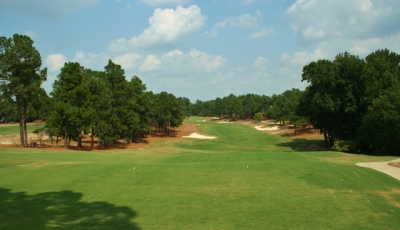 |
| From the tee of the par five 4th hole. |
He said, I have access to some photographs that probably aren’t commonly known or thought of to be in the public domain. If you want, I’ll do a little research to see if I can find any aerial photography that may have been done by the government for the military at that time.
GolfTheUnitedStates.com: Did Disher find anything?
Bill Coore: He called back like two weeks later, and said, Bill, I think I have something for you.
So Ben and I and Toby Cobb, who ran the job for us during the restoration project, we all went over to see Craig at his home there in Pinehurst, and he unveiled this aerial photograph that was actually taken when they were doing aerial photography of nearby Fort Bragg. It was from Christmas Day, 1943.
It was a fantastic photograph. Just fantastic. You can actually see people playing golf, you can see the course. It was all of the course, too. When they did this aerial photography at Fort Bragg, it was during the war, obviously. But when they did this, Craig rightly surmised that those airplanes didn’t turn on a dime, and the cameras didn’t stop taking pictures. So he thought there might be some photography like this, and when he researched it, he found out indeed there was.
So, we were just extraordinarily fortunate, because we could see greens, green outlines, fairway widths, shapes, bunkers – some of which had been abandoned. Others which have since been added, and all sorts of things. So we had a really good template there to work off of to say, okay, did Mr. Ross… if he reworked this course in 1935, and he died in 1948. So this was the end of 1943 – even though it was during the war, we made the assumption that he had it close to the way he wanted it.
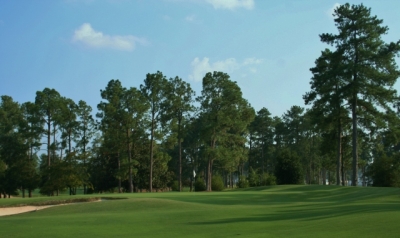 |
| Near the 13th green. |
That was basically the key that unlocked the mystery, so to speak. From that point on, it wasn’t just that we were out there guessing, saying, ‘Well, this was probably like that, or that could’ve been like this.’ Suddenly, we had a blueprint. We had the proverbial roadmap. We had the key to the mystery.
GolfTheUnitedStates.com: Almost like the Rosetta Stone of Pinehurst.
Bill Coore: It didn’t answer every question, but it certainly helped. It made us more comfortable with what we were doing. From that point, given the material that we’d found at the Tufts archives and this aerial photography, we felt quite comfortable in making recommendations as to how to proceed.
We collectively went over all this with Bob Dedman the owner and Don Padgett the president of Pinehurst and the Pinehurst staff – including Bob Farrin, who’s in charge of all the agronomy of all the courses. And we had discussions about this. “Are we willing to make this major leap?” It was a major leap because the course had been… it was still basically just as it was from the 2005 U.S. Open.
GolfTheUnitedStates.com: Can you describe that?
Bill Coore: It had extraordinarily narrow fairways lined on the sides by thick Bermuda rough. In numerous places, the rough on both sides of the fairway was actually wider than the fairway. By these old aerial photographs, we saw the fairways used to be 50-60 yards wide. Now, they’re 24… one of them literally was 11. So, after discussing it with Mr. Dedman and Don Padgett, there was a consensus among us that this restoration actually was the right thing to do, and to proceed.
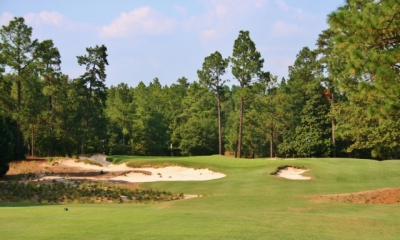 |
| The beautiful and challenging par three 9th hole. |
It was a huge risk for Mr. Dedman and the Pinehurst people. From a business standpoint, a golf standpoint – the course still was a well functioning entity. It certainly wasn’t broken from a business mode standpoint. And to say that we’re going to radically change this golf course that rightly so has become this icon in American golf…
And when there would be hardly anyone still living who had seen it in the state to which we were trying to return it… it was a major, major decision for the Pinehurst people.
I remember Bob Dedman saying, “This will either be the smartest thing I’ve ever done, or the dumbest.”
Hindsight being what it is, it turned out very well. But at the time, it was not a totally comfortable feeling. People would say, “This is going to be fantastic,” and Ben and I and Toby and all of us are going, “We hope it turns out to be fantastic.” But there’s no guarantee – this was a huge leap of faith on all of our parts.
GolfTheUnitedStates.com: Such a radical change would invariably affect the way the course plays, too. Was playability of the restored course a concern?
Bill Coore: Playability absolutely was one of the concerns. One of the primary intents – in addition to restoring the character and some thoughtfulness in how you play the course, in terms of strategy – but also the playability. Getting people around there. It used to be just hit it out there and hack it down the fairway.
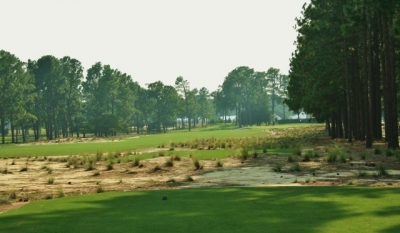 |
| Despite its sandy looks, the par four 11th hole actually offers a very wide fairway. |
I don’t know, you’d have to check with Pinehurst, but my understanding in talking to the starter there, the rounds are significantly faster than before, because players aren’t looking for balls.
They hit and they see it. They may not be too happy with where it ends up, but they continue to proceed forward in most cases. Once in awhile you could be up against a wiregrass plant or something and have to go more laterally, but for the most part, you keep going forward.
One of the biggest concerns there… I don’t know if I’d say by Ben and me and all, but by the Pinehurst people – they felt we were making the course too easy. That it was going to be so much easier without the rough.
I’m not talking about the staff at Pinehurst – I’m talking about people that play there on a regular basis. We heard that a fair amount ‘you’re making it too easy.’ Well, it’s easier for us, and therefore it’s going to be really easy for the U.S. Open.
The conditions are now such that – yeah, the greens are a little softer and the fairways are a little softer. I’m sure it’s easier than it was prior to our working there, but we’re not overly concerned about it being too easy for the U.S. Open.
GolfTheUnitedStates.com: We played #2 with a couple of pretty good recreational players who were blasting it from the white tees – often times, through the fairways into the sandy natural areas. I can guarantee you that they didn’t think the course was too easy.
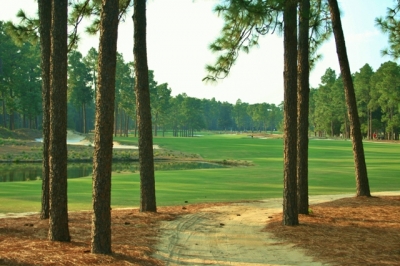 |
| Shots off the course are usually playable, but you will face this type of challenge to recover. |
Bill Coore: There’s one thing I would say to that… the #2 course has always been perceived as the most difficult course at Pinehurst. I’d like to say I have some sympathy for that – for a guy driving the ball too far through the fairways.
At some point… if you notice that the fairways are fifty yards wide back where the majority of people are hitting, and if you’re capable of driving the ball that far, you’re going to have to think like you would be if you’re playing in a competition.
That’s the whole point to those fairways narrowing down out there, which at the back tees would be 300 yards plus…
One of the things we asked Don Padgett and the Pinehurst people early on was, you know, you’re going to play the U.S. Open here in 2014 (actually, two Opens back to back, men’s and women’s). And if we restore this course back to more of its original width and hardpan sand roughs and those kinds of things – what’s going to happen then?
Is the USGA going to come in and narrow up the fairways and try to grow rough and that sort of thing – because if they do, it’s neither going to play right or is it going to look right. So they (Pinehurst) said, we’ve had some preliminary discussions with the USGA, and they’re very supportive of this. So (USGA Executive Director) Mike Davis came out and we had some lengthy conversations about all this.
It turns out they were very comfortable with the concept. Mike actually worked with us very closely to do this work. If anything, he would’ve probably preferred the fairways to be even narrower than they are – particularly out there where these guys are driving it.
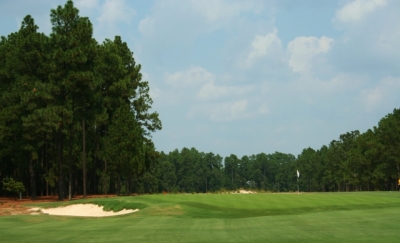 |
| The crowned greens are still at Pinehurst No. 2, vintage Donald Ross. |
There’s not going to be any rough for the U.S. Open, either. There’s just going to be fairway and that hardpan sand and wiregrasses and pine straw and that sort of thing. This was a balance that we tried to make between the resort players, most of whom are hitting way back there in those huge parts of the fairway – and the accomplished player, for competitions, or for just good players, so they had to be precise with the placement of those shots.
GolfTheUnitedStates.com: So what would you say to those guys who are bombing it away from the white tees and ending up in the sand all day?
Bill Coore: If they’re hitting it out there 300 or 310 or 320 or something (from the back tees), then they have to be precise. They have to make a decision – am I just going to hit this driver, regardless, or am I going to lay back and play this shot left to right or right to left… What am I going to do to get myself into position, because length has its own inherent advantage.
In years gone by, from an architectural standpoint, it was always deemed desirable that, because of that inherent advantage -- long players should have to drive the ball straighter than short players. Because they had such an advantage to start with.
I think that’s a little of what you see there at Pinehurst. It was hopefully a serious consideration of the resort people, the average people that go there and play… to give them room to play and get around these things, and yet, for those people who are capable of hitting the ball that far – depending on what tees they chose and everything – they are going to have to play some golf.
We weren’t going to just say, well, you can hit it long, and we’re going to give you the 50-yard wide fairway.
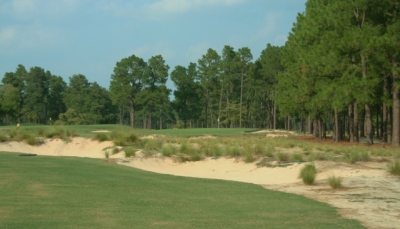 |
| The challenging par four 12th hole. |
It’s going to be pretty precise. People say, well, it’s going to be so easy for the U.S. Open because there’s no rough. But what you just described is really what we’d hoped for. If you’re going to drive the ball out there into the more narrow parts of the fairway, you’re going to have to be precise with it.
And if you miss the fairways, you might have the most perfect lie on the hardpan sand and be able to spin it to get it up on the green. Then again, you might be in a clump of wiregrass or in some pine straw where you can’t spin the ball. Or you could be in that organic stuff that’s kind of collected in areas, where again, you can’t compress the ball very well.
Those were all considerations of this. It’s going to look so easy because you hit it off the tee and you see your ball. And then you get out there, and you go ‘whoa.’
GolfTheUnitedStates.com: Right, I think I only lost one ball the whole round, despite being off the grass a number of times.
Bill Coore: Right. I think that element of uncertainty is what we like about it – and what I think Mike Davis from the USGA likes about it so much. There is, on the one hand just an illusion of just being able to blast it out there, and it’s going to go a long ways. And if you miss the fairway and you go down there, it might be just perfect.
And then there’s that mystery, that unknown. Oh my gosh, it went off the fairway – what am I going to find when I get there?
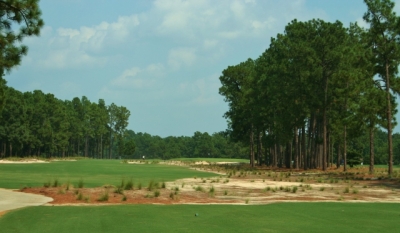 |
| The view from the tee of the par four 3rd hole. |
I remember asking Mike, what’s going to happen when two players both have missed the fairway an equal distance and one has a perfect lie to hit an iron shot up to the green and the other is behind a clump of wiregrass or on the pine straw or whatever? He just kind of smiled, and said “That is the appeal, because they’ll never know. They can’t really complain, because the next time they miss the fairway, it might be reversed.”
It was definitely a thought… and actually, I’m glad to hear what you just said. Because if guys can hit the ball 270 yards, and they’re playing from the white tees…
GolfTheUnitedStates.com: If they’re hitting it that far from the white tees, they’re probably playing it too far forward – unless they want to club down.
Bill Coore: I think at that point, you just have to say, now I’m hitting the ball where these guys in the U.S. Open are going to hit it.
And I’m going to have to think like them. Is it to my advantage to just get my driver out on every hole and say, boy, I hit it 285 and I’m in the sand again?
GolfTheUnitedStates.com: Right. Was working on the course while it was still open and having people playing it – was that an interesting experience for you?
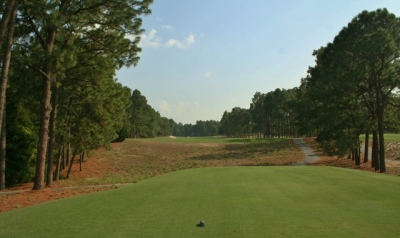 |
| The long par five 10th hole. There is a lot of grass -- and sand -- between you and the flag. |
Bill Coore: Interesting is how you want to define it. It certainly had its challenges.
We did not want to be working, neither our guys, nor Bob’s staff – we did not want to be impeding play of people who’ve come to play Pinehurst #2, and all of a sudden they’re in things and they’re torn up or there’s ground under repair and that sort of thing.
It’s just something… there were times when there were players out there. And what we tried not to do the most invasive parts of the project during the periods when anyone could be playing out there.
Now, once the course closed on November 1st, then it was a whole different thing. We went into full-speed-ahead mode and did the bigger work -- like building some tees, and some of the bunkers that were more in play – that would’ve interrupted play. We tried to save those projects until after the course closed.
That ‘big’ work for example, all that stuff we did on the right of #7 – that was done after the course had closed down for the winter.
Most of that work (when people were still out on the course) was marking out where Bermuda grass was going to be removed. And it was sprayed to kill it. Yes, you have to do that while it’s growing. There were definitely impositions that we caused for people who were playing golf that summer.
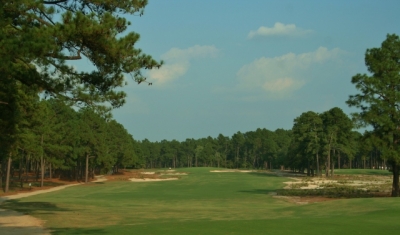 |
| The tee shot on the par four 14th hole is downhill. |
Because we were trying to get into position to have this grass out of there. You couldn’t do that in the winter, because once it went dormant – if you took the sod off before you killed it, then the next spring it’s just going to come back full-speed-ahead.
So the grass eradication happened during the summer when people were still playing.
But the major work occurred in the winter when they were closed.
GolfTheUnitedStates.com: How close would you say the final product is to the 1943 course in the photograph?
Bill Coore: I think the general shaping of the character of the bunkers is really close.
The widths of the fairways are really close, with the exception of farther out (from the tee). They used to be wider way out down the fairways in Ross’s time. That is something that we did work with Mike Davis and the USGA on. We said we just can’t make 50-yard wide fairways out here where the championship contestants are going to be driving the ball. We’ve got to narrow this down some.
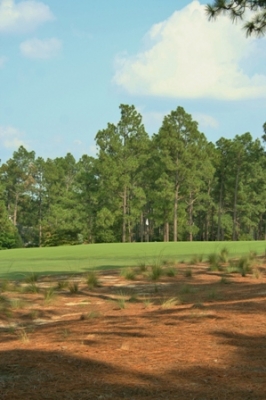 |
| In addition to the sand, expect to see a lot of pine straw. Here, the par five 8th hole. |
Mike was so fantastic. He’s such a student of golf course architecture and the love of golf. He said we don’t want to do something that would be detrimental to Pinehurst in any way. If there’s a way, you and Ben address all the issues about the restoration process, and he said, if we can just have some conversations about widths in the Open championships driving zones.
Of course, we were trying to get some answers about bunkers, too, because we were trying to restore them back to what they once were. A lot of them have no formal edges, especially on the back side. From a rules standpoint you get into… with Mike, we asked him, if we don’t have a defined edge of turf on the back of this bunker, how are you going to make a ruling?
He just had no issue with any of that. He just said, whether we define it by the rake marks or… I think that’s how they’re going to do it, but I don’t know that for sure.
We roughed in some bunkers that had no formal leading edges and that sort of thing, and he [Davis] came out and just walked around. “Mike, what do you think about this?” He just said, “I love it, I just love it. I think it’s fantastic.”
“You’re not concerned about this, like the PGA Tour would be?” We’d have to have respirators out there, because they’d say -- how are you going to make a ruling whether you’re in the bunker or out of the bunker?
Mike was like, Bill, I’m not worried about this. It’s not an issue.
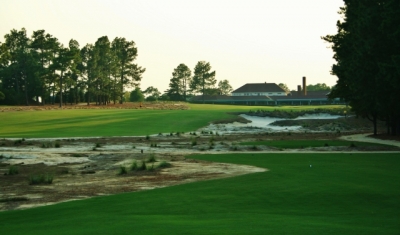 |
| At last, the tee of the finishing par four 18th hole -- a much different view than before. |
GolfTheUnitedStates.com: That must’ve been a relief. It certainly sounds like things worked out. The course is spectacular and different than most of the golf courses these days.
Bill Coore: It was definitely a collaborative effort throughout the project. It’s interesting, Don Padgett – you know, when we started, Ben and I were both concerned… could we possibly end up with a product that was harder for the resort guest? And we didn’t want to do that.
Don just said, “Bill, Ben, you guys have to realize that Pinehurst #2 – it’s history, throughout its existence, has been being the most difficult course at Pinehurst.” He said there were many times in the 30’s and 40’s when it got the least play of any course because of its difficulty. And he also mentioned that they have seven more golf courses.
This is the course that brings people here, but, because of its history and its character… we have other experiences for them. It’s not like, if it’s too difficult for some, that they have to go out there and be subjected to it again and again.
GolfTheUnitedStates.com: One note – the one gentleman in our group who had a particularly hard time on the course, especially on the back nine – he also made an eagle on number four. So he had some great holes, and others he was lucky to get a 9 or 10.
Bill Coore: Yeah. Actually, what you’ve just described is so perfect, because it allows the golf course…
Before it was restored, the golf course dictated how you had to play it – you had to hit it in the 24-yard wide spot. If not, you’re in this tall, thick Bermuda. It absolutely told you how you had to play golf there.
And now, you’re free to make your own decisions. And if your decision is, I can drive the ball a really long ways down there, and I may or may not be in the fairway, go for it. I’m not saying that’s a bad decision, that’s your decision. The golf course is not going to tell you how to play golf.
Sometimes, that’s the most frustrating thing for people, because if the golf course tells you how you have to play, it’s pretty easy to turn around and say the golf course isn’t fair or it’s this or that…
But when it gives you the freedom to make all these decisions based on your abilities and how you feel that day and how you’re playing. It in essence is like the old cliché: It gives you plenty of rope. Now what you choose to do with that rope is up to you.
If you choose to hang yourself with that rope, that’s up to you, too.
I remember at the end of the project, Don Padgett, he came out one day and we were just going around looking at the roughs and looking at all the stuff. I was so happy with the way it progressed. And he said “Bill, if I had any concerns about this project, it’s just knowing that you and Ben – and your personalities -- neither one of you is an aggressive-type personality.”
“I was a bit concerned that you would be too timid, and that you would not do enough… that you would do some, but not enough. And that it would be that sort of compromise that’s neither here nor there and it doesn’t work.”
I remember looking at him, and we were actually standing there on the 7th fairway when he said that. I looked over to the right at all the stuff and those bunkers, and I said “Don, I have an idea that you’re not worried about that anymore.”
He just laughed and said, “No I’m not, and I’m very happy.”
Details:
For the course review of Pinehurst #2: http://www.golftheunitedstates.com/story/458
For more information on Coore & Crenshaw, consult their website: http://www.coorecrenshaw.com/
For more information on Pinehurst #2:
Pinehurst Resort
1 Carolina Vista Drive,
Village of Pinehurst, NC
Phone: 800-487-4653
Website: www.pinehurst.com
Facebook.com/PinehurstResort
Packages: http://www.pinehurst.com/golf-packages/pinehurst-golf-package
| Related Links | Comments on this article? | |
|
Maryland National Golf Club Hollow Creek Golf Club Rocky Gap Resort PB Dye Golf Club in Ijamsville Whiskey Creek Golf Club |
E-mail Jeff Rendall, Editor: jrendall@golftheunitedstates.com |












